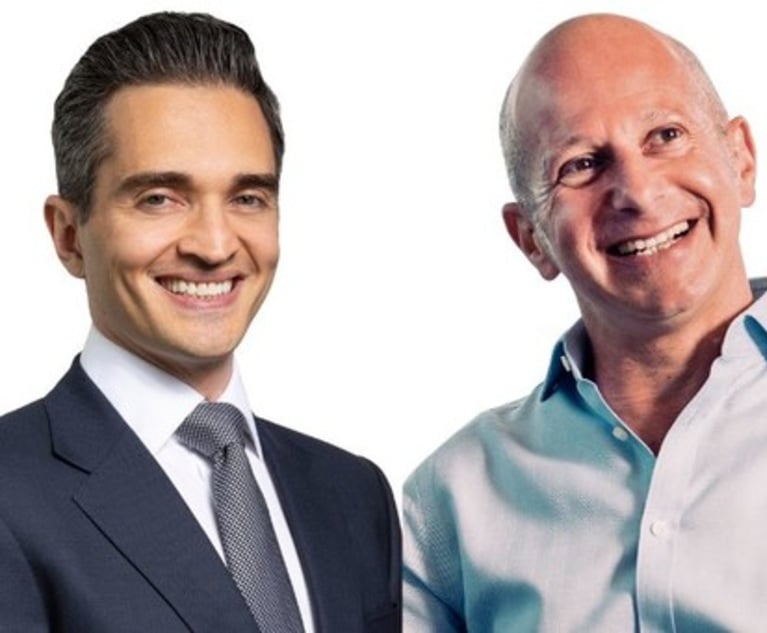Third-Party Funding: What You Need to Know
The legal industry expects that the fallout from the global COVID-19 pandemic will accelerate the use of third-party funding worldwide. Here are 15 things to know.
June 23, 2020 at 03:00 AM
9 minute read
The establishment and growth of third-party funders and third-party funding in Spain and Latin America in recent years and the consequent press coverage that they have received have created significant interest in the market from clients and practitioners alike. The fallout from the global COVID-19 pandemic is likely to accelerate and expand the use of third-party funding worldwide.
While there are those who believe that third-party funding encourages unmeritorious claims, others argue that it provides access to justice for claims with a good chance of success that would otherwise be denied a legal remedy due to a party's financial inability to pursue legitimate legal action.
It may also provide a means to convert what would otherwise be an accounting expense that reduces operating profits into free cash and therefore a real receivable on the asset side of a balance sheet. Third-party funding pays the costs of litigation or arbitration, increasing the profitability of the company, which can then allocate cash to other projects.
A positive evaluation by an independent, third-party investor may provide senior management with added comfort and confidence in determining whether to pursue a claim.
Here are 15 things to know about third-party funding:
- What are TPF agreements?
Seen primarily as being of Anglo-Saxon or Common Law derivation, TPF agreements are increasingly being used throughout the world. They have been in existence since the early 1990s. While they were originally used in litigation proceedings, they are becoming increasingly common in both commercial and investment arbitrations.
Essentially, a TPF agreement involves a third-party investor with no connection to the dispute agreeing to cover part or the full cost of the legal and ancillary expenses, such as expert fees, of litigation or arbitration. It does so after carefully evaluating the merits of each case. In return, if successful, the third-party funder takes a percentage of the final amount awarded to the funded party and/or a multiple of the amount invested by the third-party funder.
- What kinds of claims are covered by TPF agreements?
Many different kinds of claims can be covered by a TPF agreement. TPF agreements have been entered in a wide variety of disputes, including breach of contract claims, trust claims, insolvency- and fraud-related claims, professional liability claims, intellectual property and patent infringement claims, business defamations, shareholder/company disputes, tax disputes, antitrust/competition claims, class actions and investor-State and commercial arbitrations.
- When is it appropriate to use a TPF agreement?
Most typically, a TPF agreement can be used in the following situations:
- The claimant has been so damaged by the defendant that it cannot afford the litigation/arbitration process.
- The claimant is solvent and could potentially afford the litigation expenses, but it wants to focus on running its business and avoid wasting its time and resources in the litigation/arbitration process.
- The claimant would like to generate cash quickly and is willing to sell the rights to the claim for a lump sum.
- The claimant is insolvent and may have neither the money nor the ability to pursue a claim.
- Who can benefit from TPF agreements?
The claimant can be either an individual or a company. Although TPF agreements are primarily aimed at claimants, they may be also available to respondents in funding a counter-claim and/or defending a claim.
- Are TPF agreements legal?
This depends on the law and professional regulations of each jurisdiction. For many, until relatively recently, it was not possible for a third party without an interest in the proceedings to fund or invest in the same proceedings.
In order to promote increased access to justice, the law and professional rules in many jurisdictions now allow this. It is important to have a clear understanding of what is permissible. In Spain, TPF agreements are considered legal, and more and more clients are becoming aware of its advantages.
- Are only parties with limited or no finance eligible?
No. Increasingly, even well-funded or solvent parties are considering TPF agreements as a means of spreading the costs and risks of litigation or arbitration.
- What is the cost of a TPF agreement?
There is no cost associated with TPF. Indeed, even the cost of negotiating the terms of a TPF agreement may be recoverable. Hence, it is common to refer to such agreements as "no win, no fee" agreements.
- What do the funders receive?
Much will depend on the complexity and level of risk associated with the dispute. The greater the uncertainty, the greater the risk. The greater the risk, the greater the level of potential recovery for the third-party funder.
Typically, where a third-party funder is operating on a on a contingency basis, it might expect to recover between 25% and 50% of the final amount awarded. Where a third-party funder is operating on a multiplier basis, then a recovery in the event of a successful outcome might be 5 to 10 times the level of the investment, plus the return of the original investment.
Under exceptional circumstances, it is even possible to recover the TPF costs.
- Who controls the proceedings?
This has been a controversial area in recent times, with many questioning the role of the third-party funder in managing the proceedings and determining and driving strategy. In practice, it is the party and its counsel, working in close consultation with the third-party funder, that retain control of the proceedings, including in relation to settlement negotiations.
- Who are the funders, and where are they located?
They are now many more funds available to clients beyond the original specialist litigation funders. They are located all over the globe, but mainly in North America, Europe and, to a lesser extent, the Asia-Pacific region.
While there may be common characteristics of and requirements regarding third-party funders, they also vary considerably. To ensure the best deal, third-party funders must be properly identified and engaged with. Much will depend on the expertise, standing and credibility of the legal team presenting the opportunity to the third-party funder.
- What factors do the funders take into consideration regarding a claim?
The key considerations that third-party funders take into account include the following:
- The nature of the dispute
- The amount of the dispute
- The solvency/creditworthiness of the defendant
- The complexity of the dispute
- The probability of winning the claim, as well as its legal merits
- The costs estimate
- The ratio of claim value to costs
- The experience of the legal team
- The jurisdiction of the dispute
- The feasibility of enforcement
- The procedural timetable
- What is the process to obtain funding?
Generally, the first step is for the legal team to prepare a detailed proposal establishing the background of the case; the merits of the claim (including jurisdiction, liability and quantum); and an estimate of costs.
Next, a list of potential third-party funders will need to be created, with or without the assistance of a TPF broker. The prospective third-party funders will enter into a nondisclosure agreement and undertake an initial review of the claim, with the input of their own in-house or external counsel and other advisers. If interested, the third-party funder may provide outline terms of business.
A short list of prospective third-party funders is then prepared with a view to refining the outline terms of funding. Once a third-party funder is selected, detailed negotiations are undertaken, and the funding agreement is finalized. The whole process can take anywhere from a few weeks to up to six months.
- Is funding also available to enforce a judgment or an award?
Yes. As these are separate proceedings to the main merits proceedings, this will generally need to be negotiated separately. The greater the likelihood of enforcement, the more preferential the terms of the TPF agreement.
- Can TPF hinder mediation or the possibility of reaching a friendly resolution?
No. On the contrary. TPF may act as a catalyst for a negotiated agreement.
15. Are there other products available to fund proceedings?
Yes. There are a number of insurance products related to both before and after the event, as well in relation to the enforcement of judgments and awards.
The rise of TPF is nothing short of revolutionary. It has transformed the legal landscape. What was previously impermissible in almost all jurisdictions is now allowed in many parts of the world, thus providing greater access to justice.
The ever-increasing cost of contentious proceedings is a perennial problem that clients across the globe struggle with. It has become worse due to the COVID-19 pandemic, with companies and individuals applying what funding they may have to simply surviving. TPF provides an effective means to address this. However, knowing the main players in the TPF market, understanding how best to negotiate such agreements and avoiding the potential pitfalls are all factors that any party and its advisers should be aware of.
TPF has unlimited potential. In many parts of the world, such arrangements remain unaccepted or even prohibited. This would seem to give a competitive advantage to those parties that can access such a resource over those parties that cannot. Such inequality does not seem sustainable. Further expansion of the use of TPF will increase and barriers to its use will be removed as parties and their counsel better understand the options available to them and the need for additional funding grows.
Joe Tirado is an international mediator and arbitrator with the JAMS London office. He is also the global co-head of international arbitration, partner and solicitor-advocate of Garrigues UK LLP based in London.
This content has been archived. It is available through our partners, LexisNexis® and Bloomberg Law.
To view this content, please continue to their sites.
Not a Lexis Subscriber?
Subscribe Now
Not a Bloomberg Law Subscriber?
Subscribe Now
NOT FOR REPRINT
© 2025 ALM Global, LLC, All Rights Reserved. Request academic re-use from www.copyright.com. All other uses, submit a request to [email protected]. For more information visit Asset & Logo Licensing.
You Might Like
View All
What to Expect From Teresa Ribera, the EU‘s New Competition Commissioner
6 minute read
Law Firms Mentioned
Trending Stories
- 1How We Won: Samsung Defeats Data Breach Class Action
- 2With Florida’s Lateral Hiring Remaining Steady in 2024, Here’s the Top Hires Throughout the State
- 3Capital Markets Partner Rejoins O’Melveny Ahead of Expected Uptick in Demand
- 4Pharma Company Faces Breach-of-Contract Claim Over $1.3 Million in Unpaid Invoices
- 5KPMG Law Seeks Alternative Business License, Shaking Up Legal Status Quo
Who Got The Work
Michael G. Bongiorno, Andrew Scott Dulberg and Elizabeth E. Driscoll from Wilmer Cutler Pickering Hale and Dorr have stepped in to represent Symbotic Inc., an A.I.-enabled technology platform that focuses on increasing supply chain efficiency, and other defendants in a pending shareholder derivative lawsuit. The case, filed Oct. 2 in Massachusetts District Court by the Brown Law Firm on behalf of Stephen Austen, accuses certain officers and directors of misleading investors in regard to Symbotic's potential for margin growth by failing to disclose that the company was not equipped to timely deploy its systems or manage expenses through project delays. The case, assigned to U.S. District Judge Nathaniel M. Gorton, is 1:24-cv-12522, Austen v. Cohen et al.
Who Got The Work
Edmund Polubinski and Marie Killmond of Davis Polk & Wardwell have entered appearances for data platform software development company MongoDB and other defendants in a pending shareholder derivative lawsuit. The action, filed Oct. 7 in New York Southern District Court by the Brown Law Firm, accuses the company's directors and/or officers of falsely expressing confidence in the company’s restructuring of its sales incentive plan and downplaying the severity of decreases in its upfront commitments. The case is 1:24-cv-07594, Roy v. Ittycheria et al.
Who Got The Work
Amy O. Bruchs and Kurt F. Ellison of Michael Best & Friedrich have entered appearances for Epic Systems Corp. in a pending employment discrimination lawsuit. The suit was filed Sept. 7 in Wisconsin Western District Court by Levine Eisberner LLC and Siri & Glimstad on behalf of a project manager who claims that he was wrongfully terminated after applying for a religious exemption to the defendant's COVID-19 vaccine mandate. The case, assigned to U.S. Magistrate Judge Anita Marie Boor, is 3:24-cv-00630, Secker, Nathan v. Epic Systems Corporation.
Who Got The Work
David X. Sullivan, Thomas J. Finn and Gregory A. Hall from McCarter & English have entered appearances for Sunrun Installation Services in a pending civil rights lawsuit. The complaint was filed Sept. 4 in Connecticut District Court by attorney Robert M. Berke on behalf of former employee George Edward Steins, who was arrested and charged with employing an unregistered home improvement salesperson. The complaint alleges that had Sunrun informed the Connecticut Department of Consumer Protection that the plaintiff's employment had ended in 2017 and that he no longer held Sunrun's home improvement contractor license, he would not have been hit with charges, which were dismissed in May 2024. The case, assigned to U.S. District Judge Jeffrey A. Meyer, is 3:24-cv-01423, Steins v. Sunrun, Inc. et al.
Who Got The Work
Greenberg Traurig shareholder Joshua L. Raskin has entered an appearance for boohoo.com UK Ltd. in a pending patent infringement lawsuit. The suit, filed Sept. 3 in Texas Eastern District Court by Rozier Hardt McDonough on behalf of Alto Dynamics, asserts five patents related to an online shopping platform. The case, assigned to U.S. District Judge Rodney Gilstrap, is 2:24-cv-00719, Alto Dynamics, LLC v. boohoo.com UK Limited.
Featured Firms
Law Offices of Gary Martin Hays & Associates, P.C.
(470) 294-1674
Law Offices of Mark E. Salomone
(857) 444-6468
Smith & Hassler
(713) 739-1250









